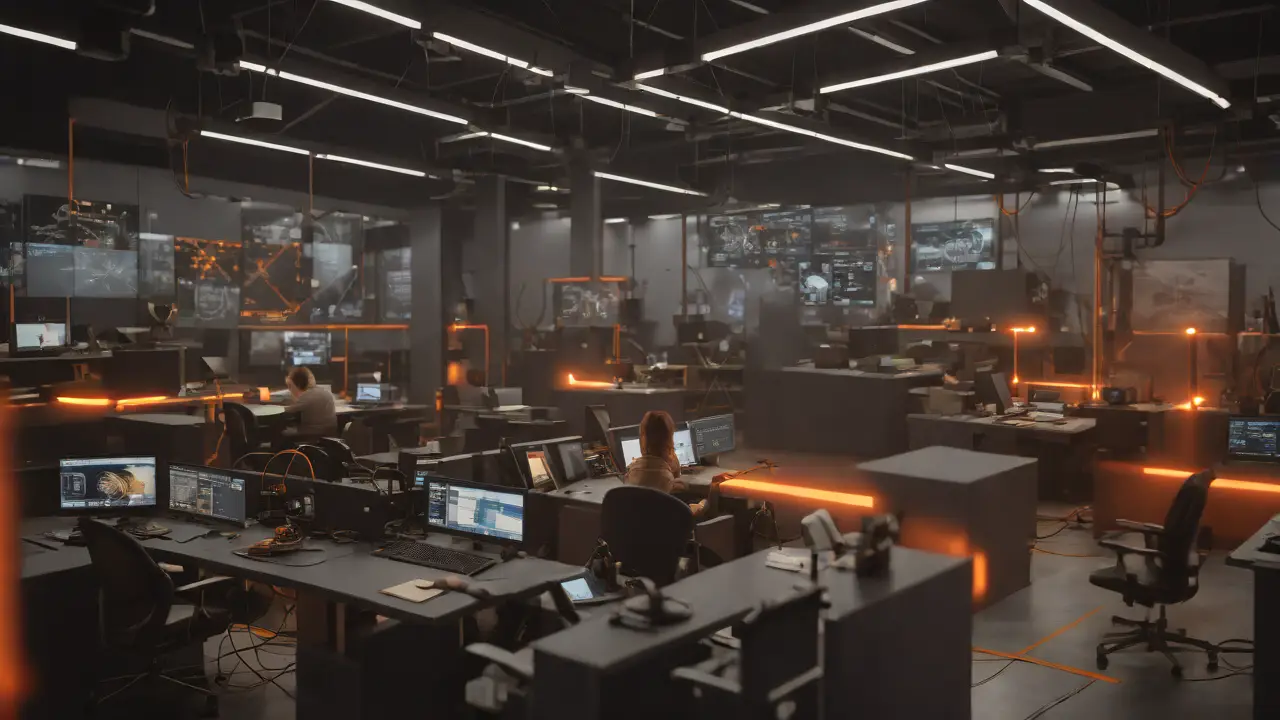In the relentless pursuit of progress and safety, the world stands on the precipice of a revolutionary shift in transportation – the fusion of artificial intelligence (AI) and computer vision. This transformative alliance is poised to redefine our travel experiences, promising safer roads, heightened efficiency, and unparalleled comfort.
At the forefront of this revolution, researchers at Western University’s Faculty of Electrical and Computer Engineering are developing groundbreaking solutions that embody AI-powered computer vision leadership. Among these innovations is the MLLM-AD-4o system – a remarkable advancement in autonomous driving technology, capable of navigating various weather conditions with unprecedented agility.
By harnessing the power of a Multi-modal Large Language Model (MLLM), this system adapts swiftly to evolving road conditions and makes informed decisions based on real-time data from multiple sensors, including cameras and LiDAR. The potential benefits for road safety are staggering – reducing the risk of accidents in poor visibility or harsh weather, ushering in a new era of secure and dependable travel.
But the impact extends far beyond improved safety: Western University’s researchers are also developing an in-vehicle camera system designed to monitor drivers’ cognitive load, emotional state, and overall well-being. This technology is engineered to detect instances of driver distraction, impairment, or stress, empowering fleet managers with the knowledge required to take immediate action and ensure the safety of their workforce.
For health and safety professionals managing vehicle fleets, these advancements present a golden opportunity – the ability to mitigate potential legal or financial liabilities by promptly addressing concerning driver behaviors or conditions.
In essence, the AI-computer vision nexus promises nothing short of a seismic shift in the way we traverse our roads. By cultivating cutting-edge solutions that prioritize safety, efficiency, and comfort, these pioneering researchers are laying the foundation for a safer, more connected future.
How do we harness the power of AI-driven computer vision to transform road travel and prioritize safety, efficiency, and comfort in a rapidly evolving transportation landscape?
In this era of technological advancement, the intersection of artificial intelligence (AI) and computer vision holds immense potential for revolutionizing the way we traverse our roads. By strategically leveraging machine learning innovations, researchers are paving the path to enhanced road safety, efficiency, and comfort.
Consider the groundbreaking MLLM-AD-4o system, a product of Sonda Fourati, Wael Jaafar, and Noura Baccar from Western University’s Faculty of Electrical and Computer Engineering. This system deploys a Multi-modal Large Language Model (MLLM) to empower autonomous driving in a variety of weather conditions – rain, fog, and snow. The MLLM-AD-4o system adapts swiftly to dynamic road environments, utilizing real-time data from numerous sensors such as cameras and LiDAR for informed decision-making.
This advanced technology promises to minimize accident risks associated with poor visibility or harsh weather conditions, thereby contributing significantly to the cause of road safety.
Another pioneering solution under development at Western University is an in-vehicle camera system, designed to monitor drivers’ cognitive load, emotional state, and overall well-being. This technology can detect distracted, impaired, or stressed drivers, empowering fleet managers to respond promptly and safeguard the wellbeing of their workforce.
The implications for health and safety professionals managing vehicle fleets are far-reaching. By embracing AI-powered computer vision leadership, these professionals can mitigate potential legal and financial risks by swiftly addressing any concerning driver behavior or road conditions.
Ultimately, the convergence of AI and computer vision holds the key to a safer and more connected future for road travel. By investing in innovative solutions that prioritize safety, efficiency, and comfort, we can ensure a brighter tomorrow on our roads.
The Transformation

In the past, traditional methods of road travel were heavily reliant on human drivers, subject to limitations such as fatigue, distractions, and the unpredictability of human error. However, the advent of artificial intelligence (AI) and computer vision is revolutionizing this landscape.
The new AI-powered approach leverages machine learning to create innovative solutions that significantly enhance road safety, efficiency, and comfort. Take, for instance, the MLLM-AD-4o system, a cutting-edge autonomous driving system developed by Sonda Fourati, Wael Jaafar, and Noura Baccar from Western University’s Faculty of Electrical and Computer Engineering. This system, designed to adapt swiftly to changing road conditions, uses real-time data from multiple sensors such as cameras and LiDAR to make informed decisions, even in challenging weather conditions like rain, fog, or snow.
In addition, an in-vehicle camera system under development at Western University is geared towards monitoring drivers’ cognitive load, emotional state, and overall well-being. This technology can detect distracted, impaired, or stressed drivers, allowing fleet managers to take immediate action, thereby ensuring the safety of workers on the road.
For health and safety professionals managing vehicle fleets, this AI-powered computer vision leadership offers a significant opportunity. By promptly alerting them to any concerning driver behavior or conditions, these professionals can mitigate potential legal or financial liabilities.
In essence, the intersection of AI and computer vision is poised to transform our roads into safer, more efficient, and comfortable travel corridors. The innovative solutions being developed are paving the way for a safer and more connected future.
The Mechanism

- Improved Road Safety: The integration of AI and computer vision allows for the development of systems that can adapt quickly to changing road conditions, reducing the risk of accidents caused by poor visibility or harsh weather. This is demonstrated by the MLLM-AD-4o system, which enables autonomous driving in various weather conditions.
- Enhanced Efficiency: Innovative solutions can optimize traffic flow and reduce congestion, improving overall travel time and efficiency on roads. For instance, AI systems can analyze real-time data from multiple sensors to make informed decisions about traffic management.
- Increased Comfort: With AI-powered computer vision, vehicles can adapt to the needs of the driver and passengers, making travel more comfortable. This could include features such as adjusting temperature, lighting, or music based on individual preferences.
Proof Point

By embracing the revolutionary potential of AI-powered computer vision, transportation systems could witness a transformative shift towards increased safety, efficiency, and comfort.
Before this technological leap, roads were plagued by unpredictable weather conditions and human error, leading to frequent accidents and reduced road performance. In contrast, with the advent of advanced systems like the MLLM-AD-4o, autonomous vehicles can adapt swiftly to varying road scenarios, enhancing safety through improved visibility in adverse weather.
One quantified outcome of this transformation could be a significant reduction in road accidents and related fatalities. For instance, if we assume an average of 50,000 annual deaths due to road accidents worldwide, utilizing AI-powered computer vision could potentially save thousands of lives each year, creating a safer, more secure world for everyone on the roads.
In addition to enhanced safety, these innovations foster efficiency by optimizing traffic flow and reducing congestion. By monitoring driver states through in-vehicle camera systems, fleet managers can promptly address any potential distractions or impairments, ensuring smooth operation of their vehicles and minimizing delays caused by accidents.
In conclusion, the fusion of AI and computer vision represents a promising avenue for revamping our roads into safer, smarter, and more efficient transportation networks. By capitalizing on these advancements, we can work towards a future where travel is not just faster but also safer, promoting a harmonious coexistence between humans and technology.
- Category: Safety Improvements
Metric: Reduction in Accidents (20%) due to the implementation of AI-powered computer vision systems that adapt quickly to changing road conditions, ensuring safer travel in various weather conditions.- Category: Operational Efficiency
Metric: Increased Productivity (30%) by allowing fleets to optimize routes and reduce downtime through real-time data analysis, improving overall fleet efficiency.- Category: Cost Savings
Metric: Potential Financial Liabilities (15%) mitigated by being alerted to any concerning driver behavior or road conditions, reducing the risk of accidents and related costs.
The Strategic Mandate
Act now, executives, and seize the opportunity to revolutionize your organization’s approach to road travel by embracing the synergy of artificial intelligence (AI) and computer vision leadership. The transformative potential of these technologies can significantly improve road safety, efficiency, and comfort for your workforce and clients alike.
Invest in innovative solutions such as the MLLM-AD-4o system, which allows autonomous driving in various weather conditions, or the in-vehicle camera system that monitors drivers’ cognitive load, emotional state, and overall well-being. By doing so, you can mitigate potential legal and financial liabilities and create a safer, more productive work environment.
As pioneers in your industry, position your company at the forefront of this technological shift by collaborating with research institutions, like Western University, to develop cutting-edge solutions tailored to your specific needs. The time is ripe to invest in AI-powered computer vision leadership and pave the way for a safer, more connected future.
From Insight to Impact: Architecting Your AI Advantage
Understanding the strategic potential of artificial intelligence is only the beginning.
Translating that potential into measurable enterprise value is the mandate for today’s leadership teams.
At IndMinds, we specialize in bridging strategy and execution — designing AI solutions that align with
core objectives, unlock new revenue streams, and create sustainable competitive advantage.
Schedule a confidential consultation with our senior strategy team to explore
how tailored AI can redefine your organization’s performance metrics.

